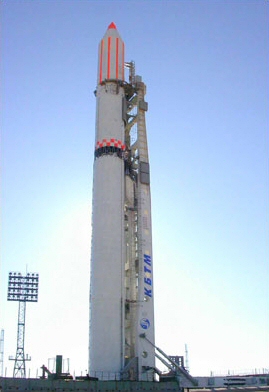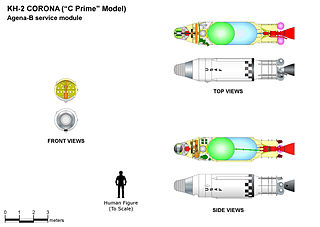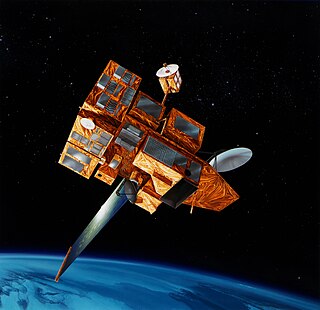Related Research Articles

Solar sails are a method of spacecraft propulsion using radiation pressure exerted by sunlight on large surfaces. A number of spaceflight missions to test solar propulsion and navigation have been proposed since the 1980s. The first spacecraft to make use of the technology was IKAROS, launched in 2010.

The Japan Aerospace Exploration Agency (JAXA) is the Japanese national air and space agency. Through the merger of three previously independent organizations, JAXA was formed on 1 October 2003. JAXA is responsible for research, technology development and launch of satellites into orbit, and is involved in many more advanced missions such as asteroid exploration and possible human exploration of the Moon. Its motto is One JAXA and its corporate slogan is Explore to Realize.
The International Designator, also known as COSPAR ID, is an international identifier assigned to artificial objects in space. It consists of the launch year, a three-digit incrementing launch number of that year and up to a three-letter code representing the sequential identifier of a piece in a launch. In TLE format the first two digits of the year and the dash are dropped.
The Small Demonstration Satellite (SDS) is a spacecraft or satellite which is built as part of a JAXA programme to develop and demonstrate technology for and through small satellites. One of the mid-term goals is also to demonstrate formation flying. SDS-1 launched aboard an H-IIA rocket on 23 January 2009, as a secondary payload to GOSAT. The operation finished successfully on September 8, 2010.

The Badr-B is the second spacecraft and the first earth observation satellite launched into Earth orbit on 10 December 2001 at 09:15 by the SUPARCO — Pakistan's national space agency. Badr-B is a microsatellite, with a mass of ~70 kg, and contained the computerized system to conduct the studies on the gravity gradient. Badr-B is a research satellite to explore the upper atmosphere and the near space, and carried a large array of instruments for geophysical research.

IKAROS is a Japan Aerospace Exploration Agency (JAXA) experimental spacecraft. The spacecraft was launched on 20 May 2010, aboard an H-IIA rocket, together with the Akatsuki probe and four other small spacecraft. IKAROS is the first spacecraft to successfully demonstrate solar sail technology in interplanetary space.

Discoverer 18, also known as Corona 9013, was an American optical reconnaissance satellite launched on 7 December 1960 at 20:24:00 GMT. It was the first successful, and the third of ten total Corona KH-2 satellites, based on the Agena-B.

ADEOS II was an Earth observation satellite (EOS) launched by NASDA, with contributions from NASA and CNES, in December 2002. and it was the successor to the 1996 mission ADEOS I. The mission ended in October 2003 after the satellite's solar panels failed.

ATS-1 was the first experimental geostationary satellite, launched in 1966. Though intended as a communications satellite rather than as a weather satellite, it carried the Spin Scan Cloud Camera developed by Verner E. Suomi and Robert Parent at the University of Wisconsin. After entering an orbit at 23,000 mi (37,000 km) above Earth, initially in orbit over Ecuador, it transmitted weather images from the Western Hemisphere, as well as other data, to ground stations, including well as video feeds for television broadcasting. It took one of the first pictures of the Earth's full-disk, on December 11, 1966.
"For the first time," historians would note later, "rapid-imaging of nearly an entire hemisphere was possible. We could watch, fascinated, as storm systems developed and moved and were captured in a time series of images. Today such images are an indispensable part of weather analysis and forecasting."
Space Tethered Autonomous Robotic Satellite II or STARS-II, was a nanosatellite built by Japan's Kagawa University to test an electrodynamic tether in low Earth orbit, a follow-on to the STARS mission.

BioSentinel is a lowcost CubeSat spacecraft on a astrobiology mission that will use budding yeast to detect, measure, and compare the impact of deep space radiation on DNA repair over long time beyond low Earth orbit.
OKEANOS was a proposed mission concept to Trojan asteroids, which share Jupiter's orbit, using a hybrid solar sail for propulsion; the sail was planned to be covered with thin solar panels to power an ion engine. In situ analysis of the collected samples would have been performed by either direct contact or using a lander carrying a high-resolution mass spectrometer. A sample-return to Earth was an option under study.
CubeSail is a proposed nanosatellite project by the Surrey Space Centre (SSC) in England. The spacecraft is to be a 3U CubeSat propelled by a 25 m²solar sail. The project is financed and technically supported by aerospace manufacturers Astrium and Surrey Satellite Technology.
EQUULEUS is a nanosatellite of the 6U CubeSat format that will measure the distribution of plasma that surrounds the Earth (plasmasphere) to help scientists understand the radiation environment in that region. It will also demonstrate low-thrust trajectory control techniques, such as multiple lunar flybys, within the Earth-Moon region using water steam as propellant. The spacecraft was designed and developed jointly by the Japan Aerospace Exploration Agency (JAXA) and the University of Tokyo.
The Innovative Satellite Technology Demonstration Program is a series of spacecraft missions for testing technology and ideas put forward by universities and private companies. The program demonstrates various experimental devices and technology in space by providing flight opportunities. It is managed by the JAXA Research and Development Directorate. According to JAXA, the goal of this program is to test high risk, innovative technology that will lead to the space industry gaining competitiveness in the international field.
RAPIS-1 is a satellite launched on 18 January 2019 which for over a year was used to test seven technology demonstration projects. RAPIS-1 was developed and operated by Axelspace Corporation, under the coordination of the Japanese space agency JAXA.
RAISE-2 is a smallsat for technology demonstration, part of the Japanese space agency JAXA's Innovative Satellite Technology Demonstration Program. RAISE-2 was launched on 9 November 2021 as the main satellite of Innovative Satellite Technology Demonstration-2. RAISE-2 was developed by Mitsubishi Electric.
RAISE-3 is a smallsat for technology demonstration developed by Mitsubishi Heavy Industries (MHI). Part of the Japanese space agency JAXA's Innovative Satellite Technology Demonstration Program, RAISE-3 carried multiple technologies that were selected for in-orbit demonstration. RAISE-3 was launched on 12 October 2022 by an Epsilon rocket as the main satellite of Innovative Satellite Technology Demonstration-3, but the launch resulted in a failure and the satellite was lost.
References
- 1 2 3 "MDS-1 – NSSDC Master Catalog". nssdc.gsfc.nasa.gov. NSSDC. Retrieved 7 January 2019.
 This article incorporates text from this source, which is in the public domain .
This article incorporates text from this source, which is in the public domain . - 1 2 "JAXA | Mission Demonstration test Satellite-1 "TSUBASA" (MDS-1)". jaxa.jp. JAXA. Archived from the original on 29 May 2013. Retrieved 7 January 2019.
- ↑ "MDS 2". space.skyrocket.de. Gunter's Space Page. Retrieved 7 January 2019.
- ↑ Kimoto, Y.; Koshiishi, H.; Matsumoto, H.; Goka, T. (December 2003). "Total dose orbital data by dosimeter onboard tsubasa (mds-1) satellite". IEEE Transactions on Nuclear Science. 50 (6): 2301–2306. Bibcode:2003ITNS...50.2301K. doi:10.1109/TNS.2003.821399.
- ↑ Koshiishi, H.; Matsumoto, H.; Kimoto, Y.; Liu, H.; Goka, T. (2002). "Space Environment Data Acquisition Equipment Board Mission Demonstration Test Satellite-1". COSPAR Colloqui Series. COSPAR Colloquia Series. 14: 369–371. doi:10.1016/S0964-2749(02)80184-6. ISBN 9780080441108.
- ↑ Koshiishi, H.; Matsumoto, H.; Goka, T. (November 2008). "Single-event upset in geostationary transfer orbit during solar-activity maximum period measured by the Tsubasa satellite". Advances in Space Research. 42 (9): 1500–1503. Bibcode:2008AdSpR..42.1500K. doi:10.1016/j.asr.2007.11.026.